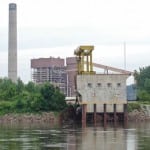The Environmental Protection Agency (EPA) last week issued a Notice of Data Availability (NODA) as a supplement to its April 2011 proposed rule for cooling water intake structures at all existing power facilities as part of section 316(b) of the Clean Water Act.
The NODA presents a summary of significant data that the federal agency has received or collected since the proposal as well as a discussion of how it is considering incorporating the data in revised analyses supporting the final rule. It essentially proposes to allow additional compliance flexibility with respect to minimum standards for the survival rates of fish that are trapped on cooling water intake screens (known as “impingement mortality” standards).
Unlike the proposed rule, which would establish a uniform impingement mortality standard applicable to all plants, the NODA proposes to allow states to set site-specific impingement requirements in situations where it is infeasible for a facility to achieve the uniform standard. The NODA also suggests alternative means by which facilities with closed-cycle cooling systems could demonstrate compliance with impingement mortality standards. The agency is now seeking public comment on the information in the NODA for 30 days upon its publication in the Federal Register.
Section 316(b) of the Clean Water Act requires that National Pollutant Discharge Elimination System (NPDES) permits for facilities with cooling water intake structures ensure that the location, design, construction, and capacity of the structures reflect the best technology available to minimize harmful impacts on the environment. Under a consent decree with environmental groups, the EPA divided cooling water rulemaking into three phases, but Phase II (which addressed existing large generating facilities) and a portion of Phase II (which addressed small facilities) were remanded to the EPA after legal proceedings.
The April 2011 proposal combines Phase II and III into one rule and covers roughly 1,260 existing facilities—670 power plants—that each withdraws at least 2 million gallons per day of cooling water. A final rule is expected this summer.
In a statement last week, the Edison Electric Institute (EEI) said it was "encouraged" by the NODA.
The industry group, whose members represent 70% of the U.S. power sector, said it had been concerned about the "inflexibility" of the April 2011 proposal’s impingement mortality standard, as well as the rule’s "definition of closed-cycle cooling, requirement for facilities with existing closed-cycle cooling systems to also comply with numeric impingement limitations, lack of de minimis relief for facilities that have little impact, inadequate consideration of cost-benefit mechanisms, and barriers to employing site-specific permitting for both impingement mortality and entrainment reductions."
The final cooling rule should rule should ensure flexibility with respect to entrainment and impingement requirements and incorporate the use of appropriate cost-benefit mechanisms to ensure that permitting decisions do not impose requirements whose costs far exceed their benefits, the group said.
“We believe the notice is an important step toward addressing these concerns, because it seeks more information on these critical issues, which must be resolved in the final rule,” EEI President Tom Kuhn said.
In a related story, the EEI on Wednesday lambasted the EPA’s "willingness-to-pay" (WTP) survey to determine the benefit of cooling water intake regulation. The survey basically determines the price that people would hypothetically assign to having a healthy fish population from which they would gain no direct benefit. It is a separate part of rulemaking warranted under the Clean Water Act.
“The very premise of the survey is misleading to the public,” Kuhn said. “It infers without any solid justification that improvements in fish populations and aquatic ecosystems can result from regulating cooling water intake structures.”
Sources: POWERnews, EPA, EEI








